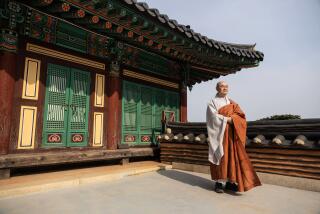The ‘Monastery’ Holds Hallowed Memories : Korean Saloon Is Place of Solace to U.S. Soldiers
CAMP BONIFAS, South Korea — A sunburned GI takes down a pint from the shelf, unscrews the cap and sips the whiskey delicately.
“We’re like the dogs who guard over hell,” he says, wiping the shot glass on his sleeve before pouring. “We (foul up) on our watch and those devils are everywhere.”
Those devils inhabit gray barracks like those at Camp Bonifas and they probably have a drinking hole like this, the Monastery, only farther to the north.
“They” are the other side, the North Koreans. Bonifas is the farthest salient of western military power in Korea. Panmunjom, the truce village, is less than a mile away. The right of way is fenced, two strands of barbed wire on willow poles, an asphalt path cut across no man’s land.
In the old days, this camp was the center of a firestorm, all that stood between Mao’s armies and mom and apple pie.
The bottle became a great solace at the 38th Parallel.
The killing ended in 1953. But the hillside camp remained. It became the advance fortress, 300 soldiers bracing for the first wave of Armageddon. Its motto: “In Front of Them All.”
The 35 years since have brought an uneasy truce. Instead of the insanity of war, there is the insanity of waiting for war.
The bottle is still the best solace.
“Our biggest worry is trying to stay sharp, waiting and waiting, and doing nothing,” says Capt. David Heany of Houston, who runs the tavern. “Whiskey takes the edge off the whole damn mess.”
To take the edge off the drinking, the Monastery was founded. It was a classy saloon for classy fighting men created only a few years after the fighting stopped. Each officer became an honorary Mad Merry Monk. Thousands passed through the fraternity during their 12-month voluntary stint in hell, good for the career, lousy on the psyche.
(The Monastery has always been a monastery in fact as well as name; women are always welcome, but never available.)
“The men arrive very enthusiastically,” says Kim Yu Pak, the Monastery’s bartender for 13 years. “But after time, that changes. They become real quiet.
“They don’t talk and joke as much,” he says. “They stay more to themselves. They spend a lot of time thinking. I think they all become more anxious to leave. The longer time you spend here, the more you think about leaving.”
The passage of time is marked by pegs on the wall. Each Monk owns an ornately embroidered hat; he hangs his hat on pegs in the order of his time left on the hill. The man with the hat on the last peg is the Merriest Monk of All. That man is Heany.
“Two weeks to go and counting,” says the captain. “Somebody else will have to take over my job and run the place,” he adds, quite happily.
A surprising number of former Monks return to the Monastery, he says. He probably will too. There are pictures, mementos and autographs from former gatherings. Now a corner of the bar is devoted to selling souvenirs. Tourists as well as former Monks flock to the camp to see the other side and contemplate the importance of this frontier.
There are T-shirts, ashtrays, buckles, hats and pins. For the men who must stay here, it was decided to manufacture a special keepsake--bronze medallions engraved with mottoes, the name Panmunjom and an individual number.
The first Monk would have No. 1. The second No. 2. And so forth. A soldier’s name could be placed relative to the next soldier’s, in chronological order.
“When our Monk ordered the medallions,” says Heany, “he told the guy who makes them to be sure that they were consecutively numbered.
“But the guy didn’t understand.”
So the medallion maker was instructed in writing. “Just number them 2, 3, 4,” the instructions went.
And that’s how the medallions came back. A couple hundred, bright and shiny and all numbered with the same inscription: “234.”
For Heany and the other weary sentries that slip-up makes the memento all the more fitting.
“Why shouldn’t the (coins) be identical?” says Heany, flipping one to a visitor. “A tour in this place and we all end up pretty much the same.”
More to Read
Sign up for The Wild
We’ll help you find the best places to hike, bike and run, as well as the perfect silent spots for meditation and yoga.
You may occasionally receive promotional content from the Los Angeles Times.






